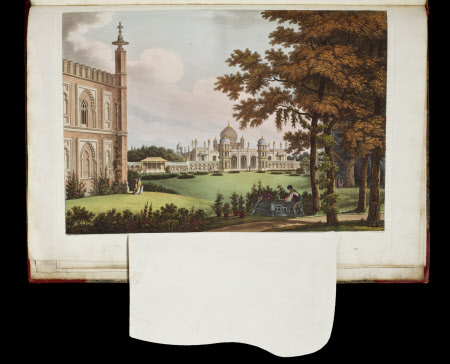Designs for the pavillon at Brighton. : Humbly inscribed to His Royal Highness the Prince of Wales. / By H. Repton, Esq. With the assistance of his sons, John Adey Repton, ... and G. S. Repton, architects.
Humphry Repton (1752 - 1818)
Category
Books
Date
1822
Materials
Place of origin
London
Order this imageCollection
Anglesey Abbey, Cambridgeshire
NT 3069089
Summary
Humphry Repton, Designs for the Pavilion at Brighton, London, [1822]. Binding: Nineteenth-century half red straight-grained morocco over boards; marbled paper sides; printed paper label on upper board with title 'Designs for the pavillon at Brighton. £6.6.0.'; spine gilt with title 'Brighton pavillon'.
Full description
In 1805 Repton visited Carlton House to present a Red Book for the Brighton Pavilion to the Prince Regent. ‘Prinny’ was delighted with the designs, exclaiming with evident excitement: ‘Mr. Repton I consider the whole of this book as perfect. I will have every part of it carried into immediate execution. Not a tittle shall be altered — even you yourself shall not attempt any improvement.’ Perhaps unsurprisingly, the designs were never carried through, and Repton's concept remained on paper only, with the original Red Book now in the Royal Library at Windsor. Repton's brief business partnership with the brilliant but wayward architect John Nash (1752-1835) did not long survive. The original conceit of turning a restrained ‘Marine Pavillion’, built by Henry Holland in 1786-7, into an Indian extravaganza was Repton's — though obviously inspired by the nearby Indian-style Riding House and Stables, built by the architect Henry Porden from 1805, and seen here in the foreground — but the building which eventually emerged was by Nash, and was finished between 1815 and 1822. The idea of an Indian house was novel, but not without precedent; Porden's master S.P. Cockerell had designed something rather similar for his brother, an Indian ‘nabob’, at Sezincote in Gloucestershire in 1805. But the fashion for Mughal buildings had already been stoked by two influential colour-plate books, William Hodge's ‘Views of India’ (London, 1786), and William Daniell's magnificent ‘Views of Oriental Scenery’, issued from 1795. The Fairhaven collection includes an especially splendid copy of the latter, and Repton himself was not far behind Daniell in spotting, in the brief fashion for Indian architecture, a business opportunity for his otherwise wasted designs for Brighton. ‘Designs for the Pavilion at Brighton’ was issued by Repton in partnership with J.C. Stadler in 1805, the project funded on a profit-share basis, but with Stadler agreeing to cover any losses. It cost six guineas to subscribers, and eight to other purchasers, and included three hand-coloured aquatints, two of them with Repton's characteristic overslips. The work was reissued with the same plates some 17 years later, presumably to coincide with renewed public interest in Brighton on Nash's final completion of the Pavilion in 1822. Text adapted from Mark Purcell's entry in ‘Treasures from Lord Fairhaven’s Library at Anglesey Abbey’, National Trust, 2013, cat. 33, pp. 108-9.
Bibliographic description
[4], x, 41, [1] p., [10] leaves of plates ([1] folded) : col. ill., map ; fol. Ephemera: loosely inserted typescript catalogue card. Provenance: Twentieth-century armorial bookplate (large variant) signed Badeley 1930: Urban Huttleston Rogers Lord Fairhaven [i.e.: Urban Huttleston Broughton (1896-1966)]. Pencil note on front free endpaper: "102 S". Binding: Nineteenth-century half red straight-grained morocco over boards; marbled paper sides; printed paper label on upper board with title 'Designs for the pavillon at Brighton. £6.6.0.'; spine gilt with title 'Brighton pavillon'.
Provenance
Acquired by Huttleston Rogers Broughton, 1st Lord Fairhaven (1896-1966) and then bequeathed by him to the National Trust with the house and the rest of the contents in 1966.
Makers and roles
Humphry Repton (1752 - 1818), author John Adey Repton (Norwich 1775 – Springfield 1860), author Repton, George Stanley, author
References
Mark Purcell, William Hale and David Person, Treasures from Lord Fairhaven’s Library at Anglesey Abbey, Swindon: National Trust; London: Scala Arts & Heritage Publishers, 2013., pp. 108-9

